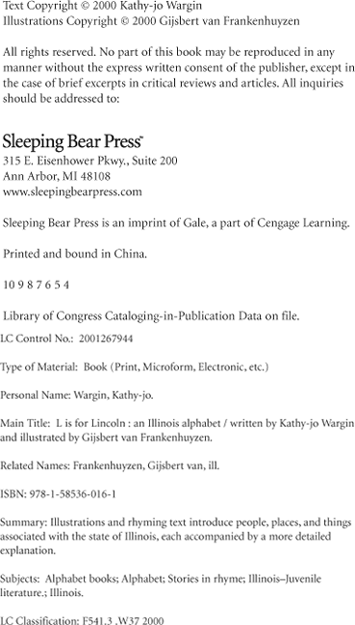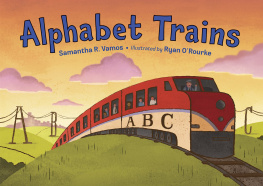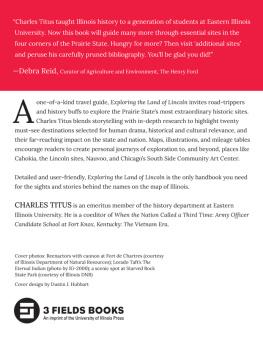L is for Lincoln
An Illinois Alphabet
Written by Kathy-jo Wargin and Illustrated by Gijsbert van Frankenhuyzen
To Kathryn Louise from Illinois, who always used to visit our family in
Minnesota when I was a little girl and tell me stories about the wonderful
place where she lived. Your smile will always remain in my heart.
KATHYJO
To Deborah Meyer, thanks for all your help, you were a great
person to work with and we couldnt have done it without you.
GIJSBERT

Kathyjo Wargin
Author Kathy-jo Wargin has written many books for children and adults. Her childrens books include the award-winning The Legend of Sleeping Bear, The Legend of Mackinac Island, The Legend of the Loon, and M is for Mitten. She has also created coffee-table books in partnership with her husband, photographer Ed Wargin, and they include Michigan; The Spirit of the Land, and The Great Lakes Cottage Book. Ms. Wargin frequently speaks to educational groups and organizations about the importance of making reading and writing fun, and conducts writing workshops and courses. Born and raised in Minnesota, she currently lives in northern Michigan, where she enjoys writing about all of the Great Lakes states.
Gijsbert van Frankenhuyzen
Gijsbert van Frankenhuyzens formal education began in 1968 when he enrolled in the Royal Academy of Arts in Arnhem, the Netherlands, to study graphic design. Upon graduating, he was employed as a commercial artist and photographer. He immigrated to Michigan in 1976 and became the art director for the Michigan Natural Resources Magazine. For 17 years he was responsible for the layout design, photos and paintings that accompanied each article.
Gijsbert is now self-employed, working from his own studio/gallery and enjoying the freedom of finally doing what he has wanted to do since he was 9 years oldillustrate childrens books. His other work is found in the Legends books written by Kathy-jo, as well as The Blue Spruce by former New York Governor Mario Cuomo and The Legend of the Teddy Bear by Frank Murphy. He traveled throughout Illinois sketching, photographing and gathering resources to help him illustrate the book. Illinois was a beautiful state to discover.
L is for Lincoln
An Illinois Alphabet
The home of one of Americas most revered Presidents is also home to American icons such as the Ferris wheel and John Deere tractors. But even a lifelong Illini might not know the full story behind the Tully Monster, the Northern Cross, or Old Quincy!
Teachers, students, and parentsfrom Chicago to the vast farmlands of Illinoiswill enjoy the clever poems, rich illustrations and revealing text of L is for Lincoln: An Illinois Alphabet.
A
Illinois is rich with artifacts. An ancient town called Cahokia, an important cultural center between 1050 and 1200 A.D., was once located near the confluence of the Mississippi and Missouri Rivers, in an area known as the American Bottom. Today, Cahokia is one of two U.S. sites listed on the United Nations World Heritage List and contains over 100 mounds, including Monks Mound, nearly 30 meters high with a base of 291 by 236 meters, and with four stepped terraces. When Cahokia was a thriving civilization, it produced arrowheads, axe heads, figurines, and other artifacts.
Illinois is also home to the Dickson Mounds, located in westcentral Illinois. They contain copper and shell artifacts as well as stone pipes and pottery from the Mississippian culture that dates back at least 1,000 years.
A is for the Arrowheads hiding in the ground, special tools from long ago waiting to be found.

B
Big Bluestem Grass is the official state prairie grass of Illinois. Long ago, when tallgrass prairie covered much of what is now Illinois, this type of prairie grass was abundant. Big Bluestem Grass can reach 3 to 10 feet in height, and as it grows, it turns from green to purple-blue.
B is also for Bluegill, the Illinois state fish, as well as Black Hawk, a renowned Native American Sauk chief and author from Illinois.
B is for Big Bluestem Grass so green when it is new, watch it grow so tall and swift and turn to purple-blue.

C
Chicago is the largest city in Illinois, and the third largest city in the United States. It is home to the tallest building in North America, the Sears Tower, which was built in 1973 and is 1,450 feet tall. It is also home to the largest building in America (excluding the Pentagon), which is called The Merchandise Mart. Chicago is also home to the Chicago River, which is the only river in the entire world that flows backward. The river was reversed in 1900 for sanitation purposes.
C is also for the Northern Cardinal, which lives here year-round and was selected in 1928 by a group of Illinois schoolchildren as the official state bird of Illinois. Males are a brilliant scarlet color, and females are soft brown with a hint of red. The Cardinal likes to eat insects, grains, and seeds, and can usually be found feeding on the ground or in low bushes.
Now C is for Chicago its called the windy city, and also for the cardinal singing clear and pretty.

D
John Deere was an inventor who revolutionized farming. When he moved to Grand DeTour, Illinois in 1836, he learned that cast-iron plows, which were used successfully in Eastern states, were not able to work through the thicker soils of the Midwest region. So Mr. Deere, along with the help of a friend, went on to invent Deeres Self-Polishing plow, a plow with a specially curved blade and parts polished so smooth that thick damp soil would not stick to them. This new piece of machinery made it possible for settlers to successfully farm in Illinois and other Midwest states.
The letter D is for Mr. Deere, he knew farming was a toil so he made a better plow to slip through midwest soil.

E
The Eastern Ribbon Snake is endangered in the state of Illinois. It has a dark body with three yellow stripes and can reach a length of 40 inches when fully grown. This type of snake is active from March to late October, and likes to feed on amphibians such as toads, frogs, and salamanders. Eastern Ribbon Snakes can be found near the many rivers and streams of Illinois.
Eastern Ribbon Snake starts with E striped with yellow do you see?
Ssssss. Ssssss. In the grass. Ssssss. Ssssss. Moving fast!

F
The very first Ferris wheel ever seen was at the Worlds Columbian Exposition in Chicago, also known as the Chicago Worlds Fair of 1893. Built by George W. Ferris, this special attraction was built with 36 cars that could each hold up to 60 people, making it possible to take more than 2,000 people for a spin at one time. It was 250 feet in diameter, 825 feet in circumference, and weighed more than 4,000 tons. This Ferris wheel was gigantic compared to the amusement park versions we know today.













